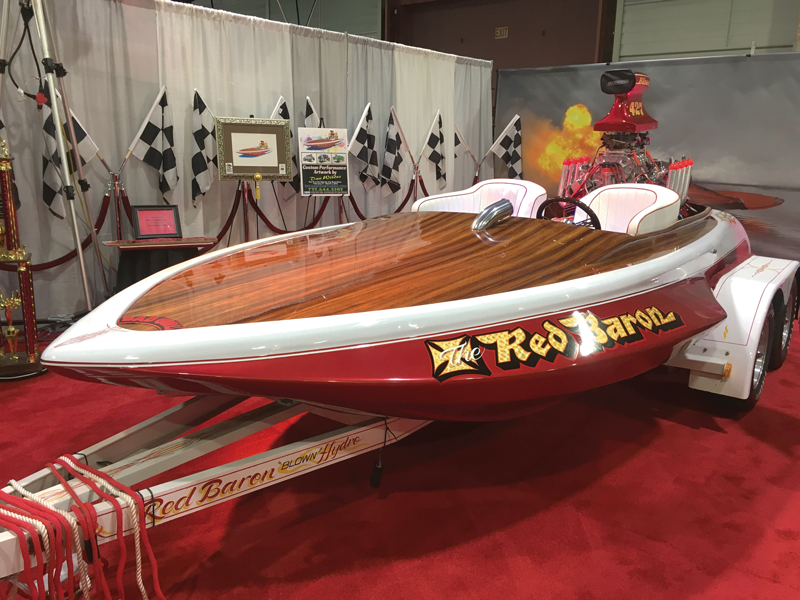The Red Baron is a blown quarter mile Stevens Hydroplane dragster that raced in the 1970s on Lake Marble Falls in Johnson Park, TX—highly popular events promoted by the Flat Bottom Association. Fred Corigliano is the boat owner as well as her driver. He shows her off proudly as she sparkles from a two-year restoration, and jokes about how “she has a boy’s name, but she’s really a girl.”

She is a 1968 model year Stevens Hydroplane—one of three Stevens Hydros left in existence. I saw this fully restored boat at a recent ACBS (Antique & Classic Boat Society) event in New Jersey. The local ACBS chapter, recently renamed the Mid-Atlantic Chapter after the Philadelphia and Barnegat Bay clubs merged, hosted this event.
Stevens Boat Manufacturing started advertising in 1962. They were a Gardena, CA, boat builder. Boats offered were a 16-foot outboard, a 17-foot V-drive, and 18-foot V-drives; all flat-bottom designs. Plus they built a few of these 18-foot hydroplane models. Rudy Ramos and his Rayson-Craft brand, that began back in the 1950s, was also a Gardena, CA, boat builder. The southern California area was a hot bed of fast boat designs and builders.
The hydroplane’s cockpit seats two in bucket seats separated by a vinyl-covered box over the driveshaft and V-drive. There is a tach plus just three other gauges on the dashboard, along with five switches to control the boat’s functions.
The Chevy engine is mounted “backwards” at the rear of the boat. The drivetrain goes forward between the two seats to the V-drive, where the power is redirected rearward under the boat and to the two-blade racing prop. She also has a separate rudder.
There is a full width cavitation plate that on a quarter-mile race course acts quicker than trim tabs. The cavitation plate is controlled by an “up and down” pedal that looks like a gas pedal as well as a “cavitation plate limiter” hand control. This system needs to be adjusted in each quarter mile run. The plate is used to set the boat on the race course in the very early part of each given run and adjusted as speed builds. The pedal acts to add “take-off” bite to set to the boat, and then the driver lets the pedal and cavitation plate relax to its top speed set, as set by the handle setting.
She uses an 8-71 Kuhl blower (supercharger) on her original L-88, 427 Chevy engine block as displayed here. While the engine block is original to the boat, the blower is not. Over the years, she has been naturally aspirated with a 4 bbl carburetor and also had a hidden or “cheater” NOS (Nitrous Oxide system). The boat has raced in several classes over the years. Since she no longer races, she now uses 115 aviation grade gasoline to operate.
Everything in the drivetrain and its accessories has been polished, chromed, or anodized. These parts are heavy-duty to handle the horsepower generated by the engine and transmitted by the driveshaft. The V-drive is a racing design, as is the rest of the driveline. The separate rudder is a spade design.
The boat hull is all fiberglass with a wood deck. The wood deck feature is “as-built” back in 1968, made from Monkey Pod wood that was the most expensive wood available back when she was built. The distinctive quality of the wood adds to this beautiful boa.
She rides on a custom tandem trailer. It is a low rider design painted in the boat’s accent colors, complete with mag wheels. Overall, it’s truly a show-stopper package.
What kind of speed? She exceeded 130-mph in the speed trap at the end of a quarter mile run. She uses two parachutes that are deployed to slow her down after a high-speed run. Those parachutes are the same design and packaging used on a land-based dragster.
I’d like to thank Bill Irving—a past race announcer and racer himself, both on land and on the water—for the rich history he shared about racing this boat. If you ever have a chance to attend one of his presentations, don’t miss it!
By Chris "Seabuddy" Brown
For more Classic Boat stories, visit our Boatshop Reports.